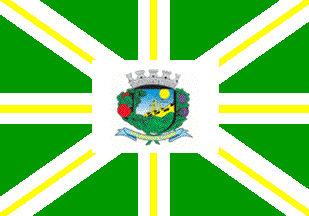 image by
Ivan Sache,
21 February 2013
image by
Ivan Sache,
21 February 2013 Based on: http://www.valinhos.sp.gov.br/portal

Last modified: 2013-03-02 by ian macdonald
Keywords: sao paulo | valinhos |
Links: FOTW homepage |
search |
disclaimer and copyright |
write us |
mirrors
 image by
Ivan Sache,
21 February 2013
image by
Ivan Sache,
21 February 2013
Based on:
http://www.valinhos.sp.gov.br/portal
A green flag with a saltire and an upright cross combined, all yellow, bordered white, with the municipal arms in the centre in a white rectangle.
Official website at
http://www.valinhos.sp.gov.br
Dirk Schönberger,
20 February 2013
Valinhos originates, according to Pr. Mário Pires, in the establishment of the Pinheiros Inn on the today's site of Capuava. The inn was built on the road between Jundiaí and Goiazes, opened by Alexandre Simões Vieira, who had been granted a domain on 2 December 1732. When the town of Valinhos proper was established is not known with precision. The municipal territory was then divided in several estates; Brigadier Luiz Antonio, owner of the Dois Córregos Estate, was considered as the richest man in the Captaincy, owning 16 sugar mills. In 1889, an epidemic of yellow fever killed 15,000 out of the 20,000 inhabitants of the town of Campinas. Most survivors moved to Valinhos, where the Campinas 6th Electoral Section was transferred. The district of Valinhos was established on 1 September 1893. The railway station of Valinhos, built by "Cia. Paulista de Estrada de Ferro", was inaugurated in 1907. Fig cultivation was initiated in Valinhos in 1901 by the Italian immigrant Lino Busatto. Commercial production started in 1910, so that Valinhos was eventually known as the Capital of Purple Fig. The municipality of Valinhos was established by State Law No. 2,456 of 30 December 1953 and inaugurated on 1 January 1955.
The flag of Valinhos is green, divided in eight quarters by a white-yellow-white cross and a white-yellow-white saltire. In the middle is placed a white rectangle charged with the municipal coat of arms.
Photo of the flag
http://www.valinhos.sp.gov.br/portal/index.php?option=com_content&view=article&id=2762
http://omelhordevalinhos.com.br/portal/?p=1791
http://www.federacaomc.org.br/fotos-filiacao-valentes.php
http://www.camaravalinhos.sp.gov.br/?module=videos
http://sindpaulista.org.br/blog/cptmcampinas/?p=1042
http://comunidadedosvereadores.blogspot.fr/2009/05/noticias-da-camara-de-valinhos-sp_07.html
The design of the flag is compliant with the traditions of Portuguese heraldry, inherited in Brazil. The coat of arms represents the municipal government, while the rectangle represents the town as the seat of the municipality.. The stripes represents the municipal power spreading all over the municipal territory. The quarters represent the rural estates located in the municipality.
The coat of arms of Valinhos is "A classical, Flemish-Iberian shield surmounted by an eight-towered mural crown argent. Azure, the iconographic representation of a factory or with four smoking chimneys on a hilly base vert dexter a fructed fig tree of the same in canton sinister an heraldic sun or. The shield supported dexter by a branch of apple tree sinister a branch of fig tree the two fructed proper. Beneath the shield a scroll azure inscribed with the motto 'IN LIBERTATE LABOR' in letters or."
The classical shield, also known as Portuguese shield, is an
historical evocation of the colonizers and main builders of the
Brazilian nation.
The mural crown is a symbol of municipal emancipation, representing a
second-rank town, seat of a "comarca".
Azure is a symbol of nobleness, perseverance, zeal and loyalty.
The factory represents the flourishing industry of the municipality.
Or is a symbol of wealth and splendour.
The hilly green base recalls the topography of the region, where fruit
trees are grown. The fig tree recalls that Valinhos is the main fig
producer in Brazil. Vert is a symbol of civility, triumph and
abundance. It is also the colour of hope, alluding to the greening
fields in spring promising profuse harvests.
The branches of apple tree and fig tree represent the main products of
the generous and fertile soil, which makes of Valinhos the Mecca of
national fruit growing.
Ivan Sache, 21 February 2013